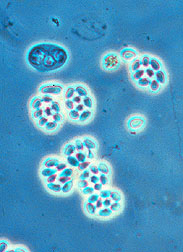This page has been archived and is being provided for reference purposes only. The page is no longer being updated, and therefore, links on the page may be invalid.
Red Imported Fire Ants...Still Going
By Tara Weaver-Missick
September 21, 1999
Biological control agents could be crucial in preventing the spread of red imported fire ants, which have recently become established in California and New Mexico. Until this recent spread, red imported fire ants occupied more than 300 million acres in 12 southern states and Puerto Rico, Agricultural Research Service scientists report. ARS is the U.S. Department of Agriculture’s chief research agency.
Researchers at ARS’ Center for Medical, Agricultural and Veterinary Entomology in Gainesville, Fla., released two biological control agents that appear promising.
Brazilian phorid flies (Pseudacteontricuspis), first released in 1997,are fire ants’ mortal enemies. The flies hover over the mound, zoom in on the fire ants, pierce the ant’s outer cuticle, and deposit an egg inside the ant. The egg quickly hatches into a fly, according to entomologist Sanford D. Porter.
Thelohania solenopsae, a microorganism from South America that infects fire ant colonies, was released in 1998. The workers probably transfer the pathogen to the queen through food exchange. She slowly loses weight and lays fewer and fewer eggs, all infected with the pathogen. Colonies generally die within 9 to 18 months, according to entomologist David F. Williams.
Two new biocontrol agents currently under study are a pathogen and phorid fly. Vairimorpha is a pathogen similar to Thelohania, but it kills colonies in two to six weeks. Pseudacteoncurvatus is a smaller phorid fly species that attacks smaller-sized fire ants.
An in-depth article on fire ant research appears in the September issue of Agricultural Research magazine. The story is also on the World Wide Web:
/is/AR/archive/sep99/ant0999.htm
Scientific contact: David Williams and Sanford Porter, ARS Imported Fire Ants & Household Insects Unit, Gainesville, Fla., phone (352) 374-5903, fax (352) 374-5818, dwilliams@gainesville.usda.ufl.edu, sdp@nervm.nerdc.ufl.edu.
Note to television news media: Video news releases are available from Tara Weaver-Missick, ARS Information Staff, phone (301) 504-1619, tweaver@asrr.arsusda.gov.


